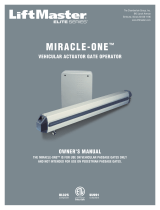
Access Panel Installation
1. Run a power cable to the location where the Rently Access Panel 3
will be mounted. Remove the security screw from the bottom of
the Access Panel 3 with the wrench that is provided and take off
the mounting plate. Apply a bead of silicone around the area
shown before mounting the plate to the wall.
2. Insert the power and control cables through the mounting plate.
secure with screws.
4. Connect the power and control cables from the Access Panel 3
according to the appropriate wiring diagram (see page 20).
nearby, you may use the 4 in antenna and tuck it into the wall. If a
stronger signal is required, the 6 ft antenna should be mounted in
a location free from large metal obstructions , including wire mesh
used for stucco.
6. Hook the top edge of the Access Panel 3 on the mounting plate
and swing the panel in until fully seated. Secure in place with the
security screw and provided wrench.
NOTE: Stow the provided security tool in an accessible location for
future service. A 6-lobe with center pin tamper resistant screw
driver may be used if needed.
ACCESS PANEL INSTALLATION 6






















